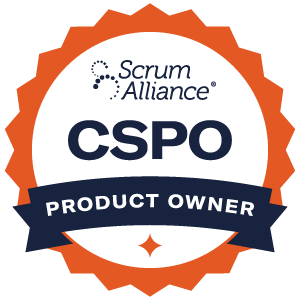Review
Review
Review
Review
Review
Review
Review
Review
Review
Review


Certified Scrum Product Owner®
-
Sat Aug 10 - 11, 2024
-
09:00 IST
-
8 hours each day
-
Live Online
-
₹17,999

Course details


Mantra:
“Scrum is simple but not easy”. Metaphorically, scrum is like losing weight!!! Conceptually losing weight is pretty simple – “Burn more calories than you take in”. However, we all know losing weight (implementation) is not at all easy for most folks. Similarly, Understanding Scrum is simple but implementing it is definitely not easy!!!
For more details about course click the following link Certified Scrum Product Owner Certification.
Training Style:
We believe that giving opportunity to experience doing scrum is critical to help participants understand scrum values, framework in right way and so as to use it when they go back to work. So we use lot of activities in our training. Participants will have opportunity to experience scrum concepts multiple times in the 2 day training.
- Training would be conducted using Agile practices. This will help participants see Agile in action.
- After teaching a concept, there will be an activity/videos for participants to experience it and validate the understanding.
For more details about course click the following link Certified Scrum Product Owner Certification.

Check Out Glimpse of StarAgile Quality Training
Liked Our Training Style?
In 2 days, participants will be doing…
- Activities to demonstrate Team self design
- Watch some fun videos on agile, scrum!!!
- Create scrum workflow in their way.
- Create Charts
- Lots of discussions, teach back, shout outs
- Take a quiz on agile and scrum concepts
- Write User stories for a sample requirement/project
- Estimate a product backlog in story points
By end of 2 days, participants will know…
- How to start/execute a project in scrum.
- How to track, report progress in scrum projects
- How to conduct scrum ceremonies
- How to use/update scrum Artifacts
- How to plan Sprints, releases
- How to create self organizing teams
- How to estimate using story points
- How “Being Agile” is more important than “Doing Agile”
Customer video testimonials:
For more details and discount codes on Scrum Product Owner Certification Training contact below numbers
+91 - 95133 93880
+91 - 89514 68937
or write us on adil@staragile.com
For more details about our trainings CLICK HERE.
Understanding the Role of the Product Owner
Fundamentals of the Product Owner Role
1.1. Responsibilities and Benefits
-
Responsibilities:
-
Defining and prioritizing the product backlog.
-
Ensuring the team works on valuable and feasible items.
-
Maximizing the product’s value.
-
-
Benefits of Scrum Team Collaboration:
-
Enhanced communication.
-
Improved product focus.
-
Increased stakeholder satisfaction through regular feedback loops.
-
1.2. Value Realization
-
Role of Product Owner:
-
Delivering product solutions that delight customers and users within the constraints of technical feasibility.
-
Continuous engagement with stakeholders to ensure alignment with user needs and organizational goals.
-
1.3. Product Owner’s Role in Scrum Events
-
Sprint Planning: Defines the sprint goal and prioritizes backlog items.
-
Daily Scrum: May attend to understand progress but does not direct.
-
Sprint Review: Presents the increment and gathers feedback.
-
Sprint Retrospective: May participate to improve processes.
1.4. Personal Qualities of a Product Owner
-
Emotional intelligence
-
Collaborative skills
-
Decision-making ability
-
Empathy with customers
-
Conflict management
-
Communication skills
-
Business acumen
-
Domain expertise
1.5. Anti-Patterns
-
Order Taker: Reduces strategic value.
-
"It’s all important": Lack of focus and prioritization.
-
Abdication of Details: Leaves the team without detailed guidance.
-
Impact on Scrum Team and Organization:
-
Loss of strategic direction.
-
Team frustration and inefficiency.
-
Poor product outcomes.
-
1.6. Organizational Contexts
-
Complete Ownership: Full oversight of customer, problem, and solution.
-
Delivery of Others’ Ideas: Executing someone else’s vision.
-
Shared Services: Managing a service used by multiple teams.
-
Impact on Approach:
-
Varies based on ownership and control over the product and its goals.
-
1.7. Why Scrum Works for Product Development
-
Real-World Product Example: Successful outcomes through feedback loops.
-
Risk Reduction: Inspection and adaptation over short timeframes.
-
Accepting Imperfect Knowledge: Enables error corrections.
Working with Stakeholders
1.8. Transparency Techniques
-
Release Burn-Up Chart: Visual representation of progress.
-
Roadmap: High-level plan outlining future product features.
-
Sprint Reviews: Regular meetings to showcase the increment.
1.9. Decision-Making Approaches
-
Product Owner Decides: Makes a decision and informs the team.
-
Consultative: Consults with the team or stakeholders before deciding.
-
Delegative: Delegates decision-making to the team when appropriate.
1.10. Facilitator Role
-
Neutral Facilitator Situations:
-
Resolving conflicts.
-
Ensuring productive meetings.
-
-
Different Engagement Approach:
-
Directing the team when necessary.
-
1.11. Stakeholder Engagement Technique
-
Affinity Grouping: Sorting ideas or feedback into categories.
Working with the Development Team
1.12. Collaboration Activities
-
Defining Done: Establishing clear criteria for completion.
-
Backlog Creation: Identifying and documenting backlog items.
-
Refinement and Ordering: Prioritizing and refining items for clarity and feasibility.
Product Ownership with Multiple Teams
1.13. Managing Dependencies
-
Techniques:
-
Coordinate with other Product Owners.
-
Redefine backlog items to remove dependencies.
-
Ensure product backlogs are visibly shared.
-
Describing Purpose and Strategy
Product Strategy
2.1. Defining Key Terms
-
Purpose: The fundamental reason for the product’s existence.
-
Vision: The long-term goal the product aims to achieve.
-
Mission: The path the product takes to achieve the vision.
-
Strategy: The approach to fulfilling the mission.
-
Tactics: Specific actions taken to execute the strategy.
2.2. Communicating Purpose
-
Describe the Problem: What problem is being solved?
-
Who is Affected: Identify the target audience.
-
Improvement Efforts: How will the team improve the situation?
-
Evaluating Effectiveness: Metrics and feedback mechanisms.
2.3. Identifying Purpose or Strategy
-
Co-Creating: Involving team and stakeholders.
-
Collaborating: Working with external partners.
2.4. External Impacts on Strategy
-
Alignment with Business: Ensuring the product strategy aligns with business objectives.
-
Hiring: Recruiting the right talent.
-
Channel Partners: Collaborating for product distribution.
-
Cost Structure: Managing financial constraints.
Roadmaps and Release Planning
2.5. Delivery Strategies
-
Opportunistic: Adapting to market changes quickly.
-
Multi-Sprint Releases: Planning releases across several sprints.
-
Fixed Date/Scope: Committing to a specific release date or feature set.
-
Release Each Sprint: Delivering usable increments at the end of each sprint.
-
Continuous Delivery: Releasing features as they are ready.
2.6. Creating a Roadmap
-
Prioritization with Stakeholders: Aligning roadmap with stakeholder priorities.
2.7. Progressive Delivery
-
Smaller Items: Breaking down features into manageable increments.
Understanding Customers and Users
Customer Research and Product Discovery
3.1. Needs of Key Groups
-
Users: Directly interact with the product.
-
Customers: Purchase the product.
-
Stakeholders: Benefit indirectly from the product’s success.
3.2. Customer Segmentation
-
Approaches:
-
Customer types.
-
Geography.
-
Regulatory bodies.
-
3.3. Product Prioritization Strategy
-
Focused Discovery: Targeting specific user segments.
-
Broad Discovery: Addressing multiple segments simultaneously.
3.4. Connecting Teams to Customers
-
Benefits:
-
Deeper understanding.
-
Increased empathy.
-
-
Techniques:
-
Job shadowing.
-
Customer interviews.
-
Usability testing.
-
3.5. Describing Users and Customers
-
Empathy Maps: Visualizing users’ thoughts and feelings.
-
Personas: Creating detailed profiles of typical users.
3.6. Generating Ideas
-
Techniques:
-
Design studio.
-
Brainstorming.
-
Collaborative customer games.
-
3.7. Aspects of Product Discovery
-
User Research: Understanding user needs and behaviors.
-
Experience Design: Crafting intuitive user interactions.
-
Usability Engineering: Ensuring the product is user-friendly.
3.8. Building Empathy
-
Techniques:
-
Job shadowing.
-
Customer interviews.
-
Customer observation.
-
Testing Product Assumptions
4.1. Sprint Review
-
Inspect-and-Adapt: Evaluate the product increment, gather insights, and discuss next steps.
4.2. Assumptions vs. Hypotheses
-
Assumptions: Beliefs held without proof.
-
Hypotheses: Testable statements validated through experimentation.
4.3. Scrum and Testing Assumptions
-
Iterative Testing: Experiment and learn within each sprint.
4.4. Opportunities for Testing
-
Stages:
-
Product discovery.
-
Product development.
-
Delivery.
-
4.5. Reasons for Discovery and Validation
-
Low Use Rate: Addressing underused features.
-
Startup Failure Rate: Mitigating risks.
-
Cognitive Bias: Reducing decision-making errors.
-
Risk Reduction: Minimizing uncertainties.
4.6. Prioritizing Assumptions
-
Criteria:
-
Highest business risk.
-
Most opportunity for learning.
-
Highest technical risk.
-
4.7. Testing Approaches
-
Cost and Learning Quality:
-
Building a potentially releasable product.
-
Interviews and research.
-
A/B tests.
-
Prototypes.
-
Working with the Product Backlog
Differentiating Outcome and Output
5.1. Outcome vs. Output
-
Output: The tangible product features delivered.
-
Outcome: The impact of those features on users and the business.
5.2. Attributes of Product Backlog Items
-
Assessing Outcome and Impact:
-
Need.
-
Value.
-
Testability.
-
Defining Value
5.3. Defining Value
-
Assumed Value: Hypothetical benefits.
-
Actual Value: Realized benefits.
-
ROI: Return on investment.
5.4. Measuring Value
-
Techniques:
-
Usage metrics.
-
NPS (Net Promoter Score).
-
Direct feedback.
-
Social media sentiment.
-
5.5. Stakeholder Perspectives
-
Different Stakeholder Groups:
-
Users.
-
Business stakeholders.
-
Development team members.
-
Ordering Items
5.6. Criteria for Ordering
-
Strategic Alignment: Fit with business goals.
-
Business Value: Impact on revenue or market position.
-
User Value: Importance to end-users.
-
Risk: Potential uncertainties.
5.7. Techniques for Ordering
-
Kano Attributes: Classifying features based on user satisfaction.
-
Validated Learning: Prioritizing based on learning outcomes.
-
Walking Skeleton: Developing a minimal yet complete version of the product.
-
Dot Voting: Team-based prioritization.
Creating and Refining Items
5.8. Sources of Product Backlog Items
-
Stakeholder Groups: Inputs from various stakeholders.
-
Regulatory Requirements: Compliance needs.
-
Defects: Issues found in the product.
-
Technical Concerns: Technical debt and improvements.
5.9. Reflecting Impact and Outcome
-
User Stories: Capturing requirements from the user perspective.
-
Hypotheses: Statements to be tested through development.
5.10. Product Backlog Refinement
-
Refinement Approaches:
-
Weekly meetings.
-
Ongoing ad hoc refinement.
-
Just-in-time refinement.
-
5.11. Just-in-Time vs. All-at-Once Refinement
-
Pros and Cons:
-
Just-in-Time: Agile, reduces waste.
-
All-at-Once: Comprehensive but potentially overwhelming.
-
5.12. Communication Tools
-
Tools:
-
Roadmaps.
-
User story maps.
-
Wireframes.
-
Flowcharts.
-
5.13. Identifying Small, Valuable Subsets
-
Approaches:
-
MVP (Minimum Viable Product).
-
Valuable vertical slices.
-
5.14. Benefits of Decomposition
-
80/20 Rule: Focus on high-value features.
-
YAGNI (You Aren’t Gonna Need It): Avoid over-building.
5.15. Refining Larger Items
-
Smaller Tasks: Breaking down large items into actionable tasks for sprints.
- Product Managers
- Product Owners
- Project Managers
- Business Analysts
- Managers
- Stakeholders
- Portfolio Managers
- Chief Operations Officers (COOs)
- Product Management Leads
- Software Development Managers
- Software Developers
- Software Testers
- People Responsible for Defining Product Vision
Reviews

best instructor
CSPO is useful course
All concepts explained nicely
Good to learn
Good and useful product taught very well
Great learning experience with practical explanation.
Attended Narshima Reddy CSPO class and it was great. Session was very interactive.
The way he explained was awesome
Good informative
Well planned and executed training with interactive patterned activities
More courses by Narasimha
 Certified Scrum Product Owner®
Certified Scrum Product Owner®
-
Wed Jul 31 - Aug 02, 2024
-
17:30 IST
-
Live Online
 Certified Scrum Product Owner®
Certified Scrum Product Owner®
-
Wed Aug 28 - 30, 2024
-
17:30 IST
-
Live Online


